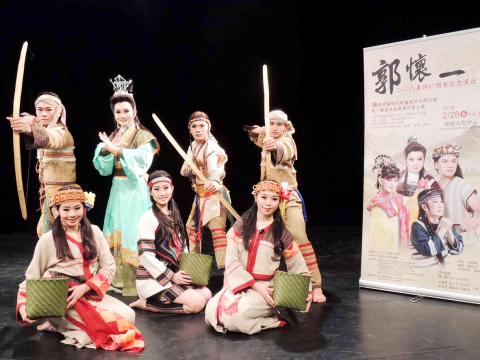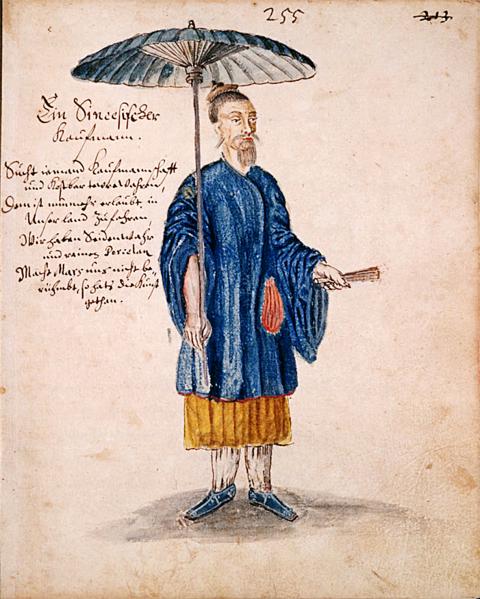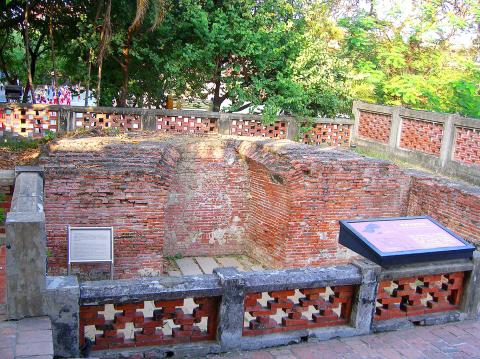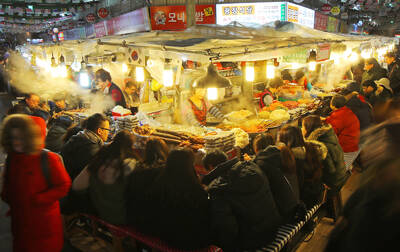SEPT. 4 to SEPT. 10
After his plans for a Mid-Autumn Festival rebellion were leaked to the authorities, Kuo Huai-yi (郭懷一) could not afford to wait any longer.
Dutch officers investigating the rumors of unrest had run into his party a night earlier, where they saw “as many Chinese gathered together as there is grass in the field,” according to a letter written by then-Dutch Formosan governor Nicolaas Verburg. All of them were armed with various primitive weapons such as bamboo spears and farming tools.

Photo : Lin Meng-ting, Taipei Times
The Dutch officers fled back to Fort Zeelandia, in today’s Tainan, where they waited until dawn on Sept. 8, 1652, when Kuo and his men charged into the Dutch neighborhoods. Despite being outnumbered, the Dutch had guns and the help of nearby Aborigines.
The battle lasted 12 days, with Kuo’s army decisively crushed. His head was later hung on a pole in front of Fort Zeelandia.
HAN IMMIGRATION

Photo courtesy of Wikimedia Commons
Before Kuo’s last stand, there were numerous clashes between Aborigines and the Dutch. But Kuo’s rebellion mostly involved Han Chinese. This is worth looking into because according to How Taiwan Became Chinese by Tonio Andrade, scholars generally agree that there were only around 1,500 to 2,000 Han Chinese in Taiwan before the Dutch arrived in 1624. Many of them were likely part-time residents, coming to Taiwan to trade, hunt and fish.
Andrade writes that at least 5,000 people participated in Kuo’s rebellion, amounting to roughly one-fourth of the Han Chinese population at that time.
How did Taiwan’s Han Chinese population increase so much in just under three decades? First of all, there was much chaos in China as the Ming Empire’s capital of Beijing fell to rebels in 1644, who in turn were driven out by the Manchus a year later.

Photo courtesy of Wikimedia Commons
But most sources agree that the Dutch had a lot to do with the mass migration as well.
Driven to desperation by societal unrest and natural disasters, many Fujianese answered the calls of the Dutch, who were seeking laborers to cultivate Taiwan’s fertile land by providing incentives such as transportation, tax breaks, oxen and farming tools.
“The company provided what would-be Chinese colonists had lacked: a military and administrative structure to support their efforts,” Andrade writes. “By subjugating the Aborigines, controlling pirates, enforcing contracts and providing policing and civil governance, it made Taiwan a safe and calculable place to live and do business in.”
Since it was illegal to set out to sea under the Ming, they were criminals once they left China. It would be unlikely that they would attempt the treacherous journey back home.
“Once they arrived in Taiwan, they were essentially cut off from their friends and family in China,” historian Su Beng (史明) writes in History of Taiwan’s Resistance (台灣抗爭史). “Geographically and socially isolated, they had little choice but to live the rest of their lives in Taiwan.”
Andrade writes that the Dutch relied much on these immigrants as they performed the “myriad jobs that underpinned Taiwan’s economy,” including clearing land for farming, hunting, building roads and driving ferries.
Things appeared to go well in the beginning, but changes in colonial policy soon led to souring of relations between these new immigrants and their Dutch overlords.
GROWING DISCONTENT
In the 1630s, the Dutch East India Company headquarters started urging the Dutch Formosa authorities to increase the colony’s revenue. To make matters worse, the chaos in China during the 1640s led to inflation of Chinese goods such as silk, which the Dutch relied on for trade.
Their solution was to impose a number of new tolls and taxes that were mostly levied on the Chinese settlers. These taxes would account for most of the colony’s revenue — Andrade writes that Verburg once commented: “The Chinese are the only bees on Formosa that give honey.”
One of these was a residency tax, which Dutch soldiers used to “exploit their right to check for residency permits, harassing travelers on the roads or conducting surprise night searches of Chinese residences.” Sometimes they even seized their belongings.
The officials urged the soldiers to restrain themselves, stating in a letter: “It is no good policy to treat so badly that immigrant nation, which has come over to us through lack of a better alternative … One should care for these people so that they might have a reason to stay where they are.”
The Dutch initially promised Chinese settlers that they wouldn’t have to pay tax on their harvests, but in the 1644 they started collecting a 10 percent rice tax. Andrade writes that this became one of the Dutch East India Company’s main sources of income from Taiwan.
That same year, they also started charging Chinese who wanted to live in Aboriginal villages or trade with them. From then on, every April Chinese merchants would openly bid for monopoly over trading rights to each Aboriginal village.
Throughout the years, complaints against treatment of Chinese by Dutch soldiers increased. Coupled with the new taxes, it was only a matter of time before resentment would explode.
The Dutch colony’s agricultural output suffered due to the death and destruction during the rebellion. The lull did not last for long, however. Thousands of new Chinese migrants arrived the next year as the Qing army pushed its way south, eventually dominating China in its entirety.
The flow of Han Chinese into Taiwan that the Dutch kicked off would continue on for the next few centuries. Today, they make up more than 95 percent of Taiwan’s population.
Taiwan in Time, a column about Taiwan’s history that is published every Sunday, spotlights important or interesting events around the nation that have anniversaries this week.

In recent weeks the Trump Administration has been demanding that Taiwan transfer half of its chip manufacturing to the US. In an interview with NewsNation, US Secretary of Commerce Howard Lutnick said that the US would need 50 percent of domestic chip production to protect Taiwan. He stated, discussing Taiwan’s chip production: “My argument to them was, well, if you have 95 percent, how am I gonna get it to protect you? You’re going to put it on a plane? You’re going to put it on a boat?” The stench of the Trump Administration’s mafia-style notions of “protection” was strong

Late last month US authorities used allegations of forced labor at bicycle manufacturer Giant Group (巨大集團) to block imports from the firm. CNN reported: “Giant, the world’s largest bike manufacturer, on Thursday warned of delays to shipments to the United States after American customs officials announced a surprise ban on imports over unspecified forced labor accusations.” The order to stop shipments, from the US Customs and Border Protection (CBP), came as a surprise to Giant, company officials said. Giant spokesman Ken Li (李書耕) said that the CPB never visited the company’s factories to conduct on-site investigations, nor to interview or

Every now and then, it’s nice to just point somewhere on a map and head out with no plan. In Taiwan, where convenience reigns, food options are plentiful and people are generally friendly and helpful, this type of trip is that much easier to pull off. One day last November, a spur-of-the-moment day hike in the hills of Chiayi County turned into a surprisingly memorable experience that impressed on me once again how fortunate we all are to call this island home. The scenery I walked through that day — a mix of forest and farms reaching up into the clouds

“Eighteen years ago, people didn’t even know the name of this ingredient,” says 58-year-old Gil Sa-hyeon, holding up a cluster of dried brownish stems. “Now it’s everywhere.” His shop, Joseon Yakcho, sits in the heart of Seoul’s Yangnyeongsi Market, South Korea’s largest traditional medicinal herb market, its streets lined with shops displaying buckets of herbs such as licorice root and cinnamon bark that spill on to the pavements, filling the air with their distinct, earthy aroma. The ingredient Gil is referring to is hovenia dulcis, known in Korean as heotgae — the oriental raisin tree that’s become the cornerstone of South Korea’s